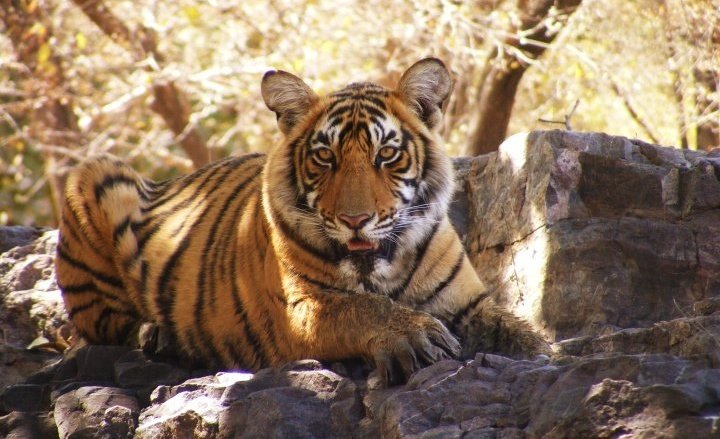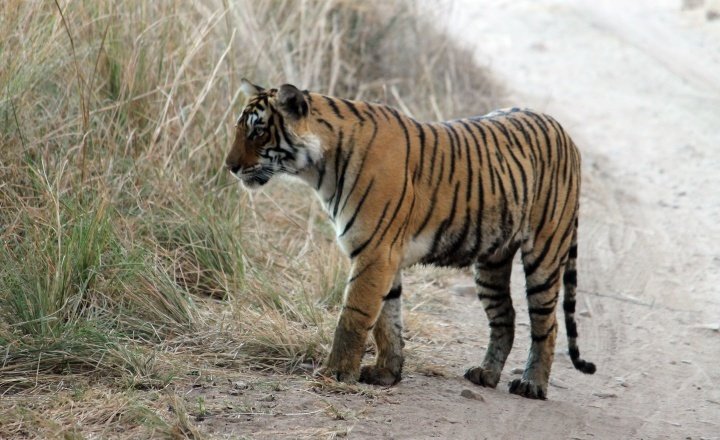While wildlife tourism serves as a revenue source for conservation efforts, it may have unintended consequences on the well-being of endangered mammal species. A new study reveals that tiger populations in protected areas experience elevated stress levels during the tourism season, which can negatively affect their health and reproduction.

Wildlife tourism is often advocated as a prime tool for conservation. A jungle safari on a vacation itinerary is undoubtedly an opportunity to observe some spectacular wildlife in their native habitats. However, if you have gone on such a safari recently, you may have faced the sight of a tiger surrounded by vehicles full of tourists, numerous cameras continuously flashing at it.
In a recent study, researchers led by Govindaswamy Umapathy, Principal Scientist at the Laboratory for the conservation of endangered species (LaCONES), Centre for cellular and molecular biology (CCMB), Hyderabad, examined the relationship between tourism and stress levels in tigers in the Kanha and Bandhavgarh Tiger reserves in central India.
With rapid urbanization, conversion of natural landscapes to agricultural fields results in large wild spaces getting divided up into smaller ones, a process called ‘parcelization’. This has led to the extinction of many species and is pushing several more to the brink. Wildlife tourism might be another addition to the list of threats that particularly affect large and charismatic mammals with high touristic value such as elephants and tigers.
The tourism industry has dramatically grown in recent years, generating revenue that aids in conservation. But there are growing concerns about the negative consequences of unbridled tourism on the conservation of wildlife and natural habitats.
The new study suggests that unrestrained tourism along with other anthropogenic factors induces stress in tigers, which is directly contrary to the intended objectives of a protected area. In response to stress, the body releases glucocorticoid hormones, which regulate many biological processes. Higher glucocorticoid levels, thus, indicate increased stress. Though glucocorticoids can be estimated using blood, saliva, hair and feathers, measuring glucocorticoids metabolites (fGCM) from faeces is a non-invasive method for quantification of stress in wildlife.

During the tourist season of 2015 (January and March), the researchers set out to collect tiger faecal samples in the Kanha and Bandhavgarh tiger reserves. The team collected samples from areas that were accessible to tourists, as well as areas that were not. To test for seasonal variations, they also collected samples during the month of September, during which the parks were closed for tourism. Both of these tiger reserves are popular for tiger sightings amongst tourists and wildlife photographers. These pristine patches of forests also harbour high cattle densities associated with a significant human population residing in the buffer zones and villages on the periphery of the reserves.
The researchers compared fGCM concentrations in tiger faecal samples from the tourist-accessible and non-accessible areas to estimate how much stress the animals were under. In addition, they estimated the number of tourist vehicles on each forest trail and other potential anthropogenic stressors such as human/cattle densities and wood logging.
The study revealed that the stress levels of tigers (as indicated by fGCM concentrations) were high in both parks. The team observed that tiger stress levels were higher during tourism season and were positively correlated with the number of tourist vehicles visiting the park. The researchers also found that disturbance caused by cattle and human movements inside the park led to spikes in fGCM concentrations. Although the study did not show any significant difference in fGCM concentrations between males and females, the researchers warn that chronic stress can produce detrimental effects on the females of the species which can lead to a progressive decline in tiger populations.
“This study is an attempt to understand the effects of tourism on the physiology of animals that already suffer from traditional threats like climate change, habitat alterations and poaching,” says Abhinav Tyagi, first author of the study.
Abishek Harihar, a leading conservation biologist at Panthera, USA, who was not associated with this study says “This study highlights tourism as a potential threat to tiger populations. Indirect pathways through which species are affected are understudied and hence conservation action to mitigate the effects of such threats are not often considered.” Panthera is one of the world’s leading organisations dedicated to wild cat conservation and supports various tiger conservation efforts across tiger range countries, including India.
Though wildlife watching is an important tool for conservation and generating local employment and revenues, this study indicates that high traffic volumes inside protected areas may become a new serious threat to wildlife in India.
Did you enjoy this article? Please let us know in the comments below.